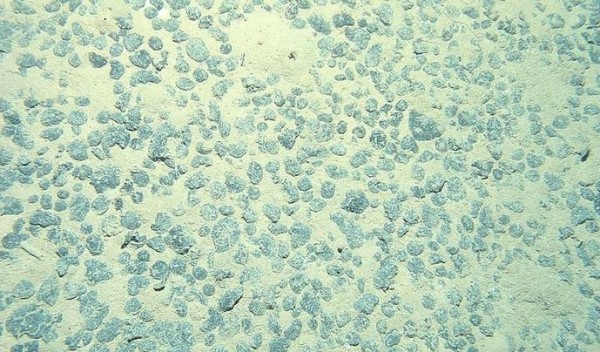Are These 'Alien', Underwater Balls a Mineral Mother Lode?
| Arthur Dominic Villasanta | | Feb 20, 2015 11:52 AM EST |
Manganese nodules strewn on the seafloor
They do look strange and alien, those millions and millions of spherical manganese nodules scattered over the floor of the Pacific Ocean.
They're alien because scientists can't seem to agree on the process that formed these potato-sized lumps of rock, also called polymetallic nodules. Scientists, however, agreed the "alien" metal balls seem to be native to the Pacific, that is, until a research ship searching for marine life recently discovered tons of them in the Barbados.
Like Us on Facebook
One theory says the nodules were formed by chemical reactions in seawater and was assisted by microbes. Another theory said the balls they were formed by precipitation of metals from seawater, especially from volcanic thermal vents.
These manganese metal balls spread out across the Pacific Ocean shave been puzzling scientists since they were discovered in 1873. Research into these balls has led to their being classified as\ manganese nodules containing iron and other metals such as copper or zinc.
In 2013, however, German scientists discovered these balls on the seafloor of the Atlantic Ocean off Barbados. German scientists were astonished by the discovery. Colin Devey, chief scientist for the expedition at the Geomar Helmholtz Centre for Ocean Research told LiveScience he was surprised "because this is generally not the place you think of for manganese nodules".
The discovery of these manganese balls in the Atlantic might resurrect the concept of mining these manganese balls as a source of raw materials. And contrary to its name, nickel was the most important element derived from these manganese balls.
The last great effort to mine or dredge manganese balls in quantity took place in the 1970s when an international joint venture scooped-up massive quantities of manganese nodules from the eastern equatorial Pacific Ocean at a depth of 18,000 feet.
Large amounts of nickel plus copper and cobalt were extracted from balls using both pyrometallurgical and hydrometallurgical methods. The project was subsequently abandoned for market reasons and only Japan's Sumitomo Metal Mining continues to maintain a small mining organization.
Scientists also have an interest in a more detailed analysis of the nodules since this might reveal the secrets of the Earth's changing climate. Some of the nodules could be 10 million years old, and seem to have grown between one to five millimeters in a million years.
©2015 Chinatopix All rights reserved. Do not reproduce without permission
EDITOR'S PICKS
-

Did the Trump administration just announce plans for a trade war with ‘hostile’ China and Russia?
-

US Senate passes Taiwan travel bill slammed by China
-

As Yan Sihong’s family grieves, here are other Chinese students who went missing abroad. Some have never been found
-

Beijing blasts Western critics who ‘smear China’ with the term sharp power
-

China Envoy Seeks to Defuse Tensions With U.S. as a Trade War Brews
-

Singapore's Deputy PM Provides Bitcoin Vote of Confidence Amid China's Blanket Bans
-

China warns investors over risks in overseas virtual currency trading
-

Chinese government most trustworthy: survey
-

Kashima Antlers On Course For Back-To-Back Titles
MOST POPULAR
LATEST NEWS
Zhou Yongkang: China's Former Security Chief Sentenced to Life in Prison

China's former Chief of the Ministry of Public Security, Zhou Yongkang, has been given a life sentence after he was found guilty of abusing his office, bribery and deliberately ... Full Article
TRENDING STORY

China Pork Prices Expected to Stabilize As The Supplies Recover

Elephone P9000 Smartphone is now on Sale on Amazon India

There's a Big Chance Cliffhangers Won't Still Be Resolved When Grey's Anatomy Season 13 Returns

Supreme Court Ruled on Samsung vs Apple Dispute for Patent Infringement

Microsoft Surface Pro 5 Rumors and Release Date: What is the Latest?










